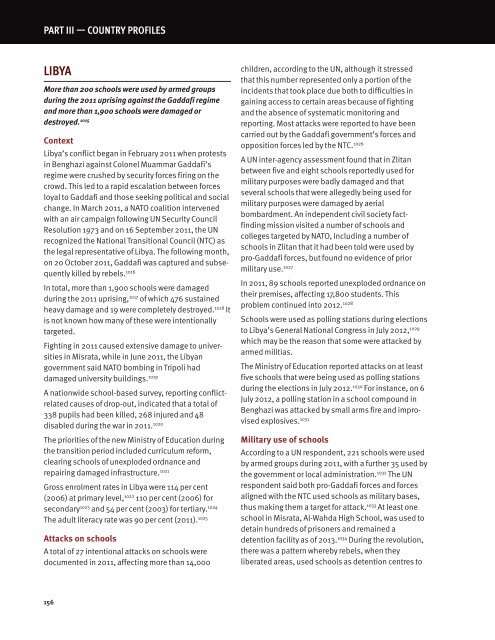Create successful ePaper yourself
Turn your PDF publications into a flip-book with our unique Google optimized e-Paper software.
PART III — COUNTRY PROFILeS<br />
LIBYA<br />
More than 200 schools were used by armed groups<br />
during the 2011 uprising against the Gaddafi regime<br />
and more than 1,900 schools were damaged or<br />
destroyed. 1015<br />
Context<br />
Libya’s conflict began in February 2011 when protests<br />
in Benghazi against Colonel Muammar Gaddafi’s<br />
regime were crushed by security forces firing on the<br />
crowd. This led to a rapid escalation between forces<br />
loyal to Gaddafi and those seeking political and social<br />
change. In March 2011, a NATO coalition intervened<br />
with an air campaign following UN Security Council<br />
Resolution 1973 and on 16 September 2011, the UN<br />
recognized the National Transitional Council (NTC) as<br />
the legal representative of Libya. The following month,<br />
on 20 October 2011, Gaddafi was captured and subsequently<br />
killed by rebels. 1016<br />
In total, more than 1,900 schools were damaged<br />
during the 2011 uprising, 1017 of which 476 sustained<br />
heavy damage and 19 were completely destroyed. 1018 It<br />
is not known how many of these were intentionally<br />
targeted.<br />
Fighting in 2011 caused extensive damage to universities<br />
in Misrata, while in June 2011, the Libyan<br />
government said NATO bombing in Tripoli had<br />
damaged university buildings. 1019<br />
A nationwide school-based survey, reporting conflictrelated<br />
causes of drop-out, indicated that a total of<br />
338 pupils had been killed, 268 injured and 48<br />
disabled during the war in 2011. 1020<br />
The priorities of the new Ministry of Education during<br />
the transition period included curriculum reform,<br />
clearing schools of unexploded ordnance and<br />
repairing damaged infrastructure. 1021<br />
Gross enrolment rates in Libya were 114 per cent<br />
(2006) at primary level, 1022 110 per cent (2006) for<br />
secondary 1023 and 54 per cent (2003) for tertiary. 1024<br />
The adult literacy rate was 90 per cent (2011). 1025<br />
Attacks on schools<br />
A total of 27 intentional attacks on schools were<br />
documented in 2011, affecting more than 14,000<br />
children, according to the UN, although it stressed<br />
that this number represented only a portion of the<br />
incidents that took place due both to difficulties in<br />
gaining access to certain areas because of fighting<br />
and the absence of systematic monitoring and<br />
reporting. Most attacks were reported to have been<br />
carried out by the Gaddafi government’s forces and<br />
opposition forces led by the NTC. 1026<br />
A UN inter-agency assessment found that in Zlitan<br />
between five and eight schools reportedly used for<br />
military purposes were badly damaged and that<br />
several schools that were allegedly being used for<br />
military purposes were damaged by aerial<br />
bombardment. An independent civil society factfinding<br />
mission visited a number of schools and<br />
colleges targeted by NATO, including a number of<br />
schools in Zlitan that it had been told were used by<br />
pro-Gaddafi forces, but found no evidence of prior<br />
military use. 1027<br />
In 2011, 89 schools reported unexploded ordnance on<br />
their premises, affecting 17,800 students. This<br />
problem continued into 2012. 1028<br />
Schools were used as polling stations during elections<br />
to Libya’s General National Congress in July 2012, 1029<br />
which may be the reason that some were attacked by<br />
armed militias.<br />
The Ministry of Education reported attacks on at least<br />
five schools that were being used as polling stations<br />
during the elections in July 2012. 1030 For instance, on 6<br />
July 2012, a polling station in a school compound in<br />
Benghazi was attacked by small arms fire and improvised<br />
explosives. 1031<br />
Military use of schools<br />
According to a UN respondent, 221 schools were used<br />
by armed groups during 2011, with a further 35 used by<br />
the government or local administration. 1032 The UN<br />
respondent said both pro-Gaddafi forces and forces<br />
aligned with the NTC used schools as military bases,<br />
thus making them a target for attack. 1033 At least one<br />
school in Misrata, Al-Wahda High School, was used to<br />
detain hundreds of prisoners and remained a<br />
detention facility as of 2013. 1034 During the revolution,<br />
there was a pattern whereby rebels, when they<br />
liberated areas, used schools as detention centres to<br />
156



